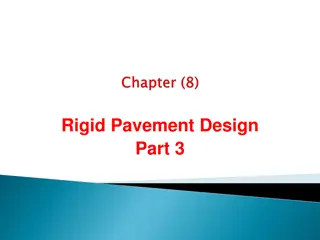Introduction to Rigid Pavement Design in Highway Engineering
Rigid pavements, made of cement or reinforced concrete slabs, are designed to resist traffic loads by distributing them over a wide area of soil. The design focuses on providing a structurally strong concrete slab. Minor variations in subgrade strength have little impact on rigid pavement capacity, as the flexural strength of the concrete plays a crucial role. Different types of rigid pavements include Jointed Plain Concrete Pavement (JPCP), Jointed Reinforced Concrete Pavement (JRCP), Continuous Reinforced Concrete Pavement (CRCP), and Pre-stressed Concrete Pavement (PCP).
Download Presentation

Please find below an Image/Link to download the presentation.
The content on the website is provided AS IS for your information and personal use only. It may not be sold, licensed, or shared on other websites without obtaining consent from the author. Download presentation by click this link. If you encounter any issues during the download, it is possible that the publisher has removed the file from their server.
E N D
Presentation Transcript
Third Stage Lecture1 Lecture. Dr. Rana Amir Yousif Highway and Transportation Engineering Al-Mustansiriyah University 2017
References: 1. Nicholas J. Garber and Lester A. Hoel. Traffic and Highway Engineering , Fourth Edition. 2.Yoder; E. J. and M. W. Witczak, Principles of Pavement Design , A Wiley- Interscience Publication, John Wiley & Sons Inc., U.S.A., 1975. 3. Yaug H. Huang, Pavement Analysis and Design , Prentic Hall Inc., U.S.A., 1993. 4. AASHTO Guide for Design of Pavement Structures 1993 , AASHTO, American Association of State Highway and Transportation Officials, U.S.A., 1993. 5. Oglesby Clarkson H., Highway Engineering , John Wiley & Sons Inc., U.S.A.,1975.
A rigid pavement is constructed from cement concrete or reinforced concrete slabs. Grouted concrete roads are in the category of semi-rigid pavements. The design of rigid pavement is based on providing a structural cement concrete slab of sufficient strength to resists the loads from traffic. The rigid pavement has rigidity and high modulus of elasticity to distribute the load over a relatively wide area of soil.
Minor variations in subgrade strength have little influence on the structural capacity of a rigid pavement. In the design of a rigid pavement, the flexural strength of concrete is the major factor and not the strength of subgrade. Due to this property of pavement, when the subgrade deflects beneath the rigid pavement, the concrete slab is able to bridge over the localized failures and areas of inadequate support from subgrade because of slab action
Rigid pavements can be classified into four types: Jointed plain concrete pavement (JPCP), Jointed reinforced concrete pavement (JRCP), Continuous reinforced concrete pavement (CRCP), and Pre-stressed concrete pavement (PCP).
Jointed Plain Concrete Pavement: are plain cement concrete pavements constructed with closely spaced contraction joints. Dowel bars or aggregate interlocks are normally used for load transfer across joints. They normally have a joint spacing of 5 to 10m. Jointed Reinforced Concrete reinforcements do not improve the structural capacity significantly, they can drastically increase the joint spacing to 10 to 30m. Dowel bars are required for load transfer. Reinforcement's help to keep the slab together even after cracks. Continuous Reinforced Concrete Pavement: Complete elimination of joints are achieved by reinforcement. Pavement: Although
Traditionally fatigue cracking has been considered as the major, or only criterion for rigid pavement design. The allowable number of load repetitions to cause fatigue cracking depends on the stress ratio between flexural tensile stress and concrete modulus of rupture. Of late, pumping is identified as an important failure criterion. Pumping is the ejection of soil slurry through the joints and cracks of cement concrete pavement, caused during the downward movement of slab under the heavy wheel loads. Other major types of distress in rigid pavements include faulting, spalling, and deterioration.
Flexible Pavement Flexible Pavement Rigid Pavement Rigid Pavement It consists of a series of layers with the highest quality materials at or near the surface of pavement. It reflects the deformations of subgrade and subsequent layers on the surface. Its stability depends upon the aggregate interlock, particle friction and cohesion. It consists of one layer Portland cement concrete slab or relatively high flexural strength. 1 1 It is able to bridge over localized failures and area of inadequate support Its structural strength is provided by the pavement slab itself by its beam action. 2 2 3 3 Pavement design is greatly influenced by the subgrade strength. It functions by a way of load distribution through the component layers Flexural strength of concrete is a major factor for design. It distributes load over a wide area of subgrade because of its rigidity and high modulus of elasticity. Temperature changes induce heavy stresses in rigid pavements. 4 4 5 5 Temperature variations due to change in atmospheric stresses in flexible pavements. Flexible properties due to heavier wheel loads are recoverable due to some extent. 6 6 conditions do not produce pavements have self-healing Any excessive deformations occurring due to heavier wheel loads are not recoverable, i.e. settlements are permanent. 7 7























